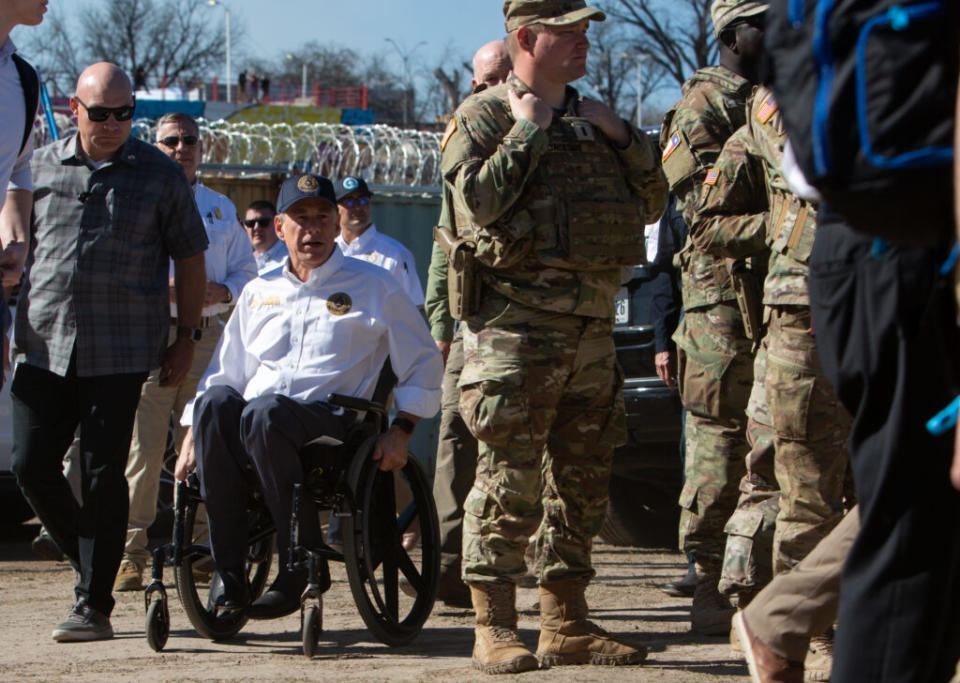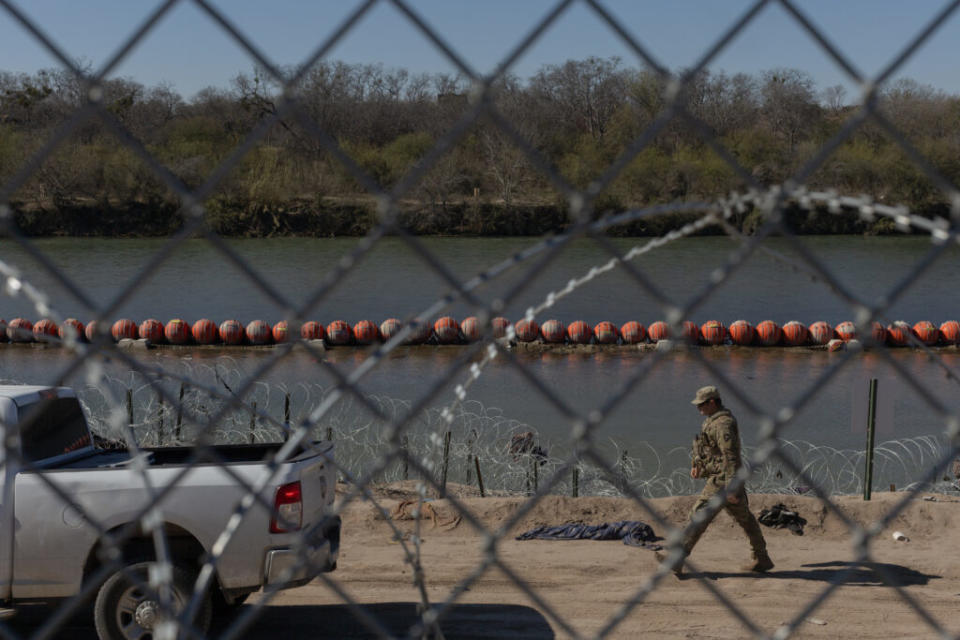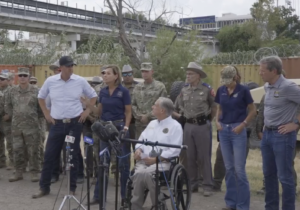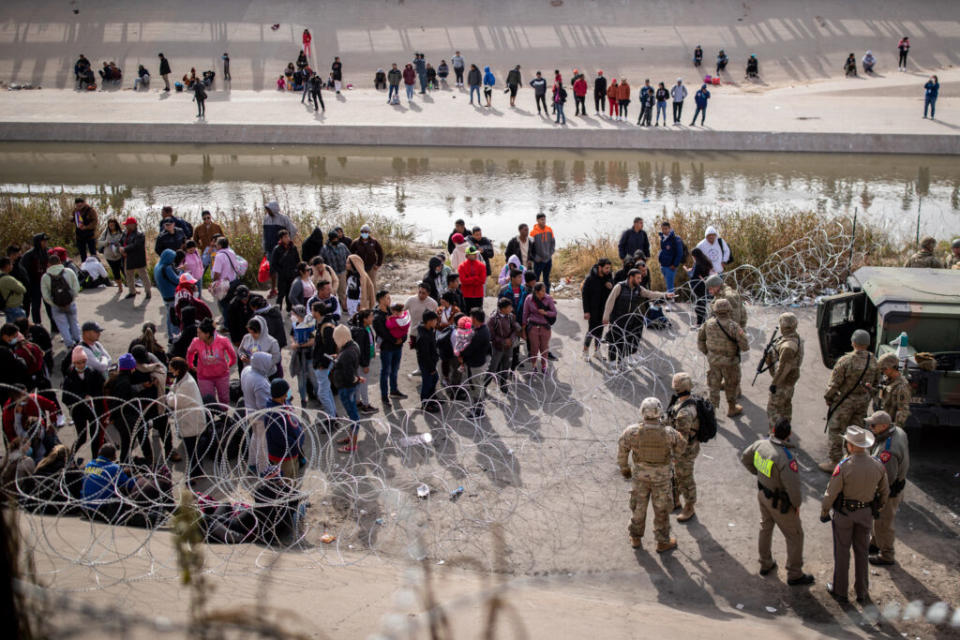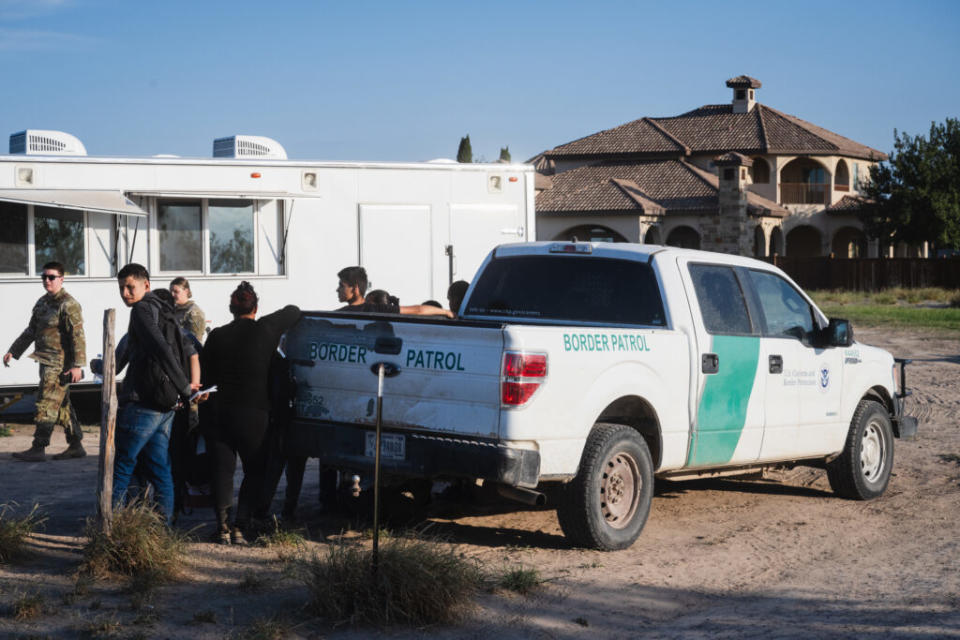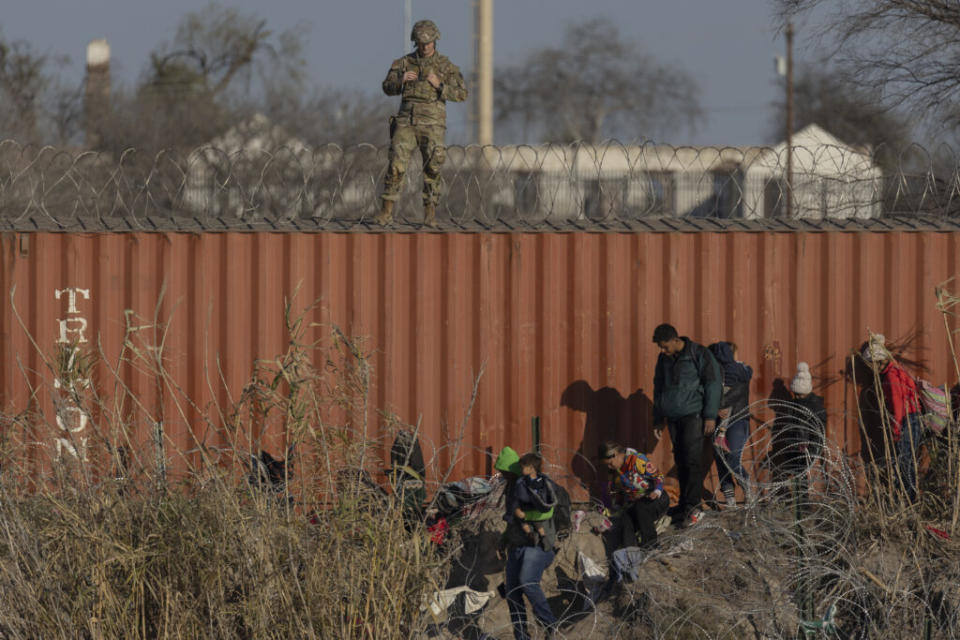A soldier with the South Dakota National Guard stands near the banks of the Rio Grande in Eagle Pass on Sept. 11, 2024. (Photo by Justin Hamel)
More than a dozen Republican governors gathered in Eagle Pass in February, heeding a call from Texas Gov. Greg Abbott to confront what he labeled “President Joe Biden’s border crisis.” The governors, along with other GOP state leaders, vowed to send another round of National Guard troops from their states to the Texas-Mexico border.
With shifts in pandemic-era federal border policies, there’d been a sharp increase in migrant encounters in the latter half of 2023. But then January saw a steep 50% drop.
Still, the governors told their constituents that they needed to send more people to assist Texas in fending off an “invasion,” as both Abbott and Florida Gov. Ron DeSantis have called it, or fight drug smuggling. But the deployments have been widely criticized as political grandstanding — opportunities to take photos near personnel in uniform on the border while feeding nationalism and fear during an election year.
States Newsroom outlets across the country have tracked state deployments and expenses so far this year as part of a collaboration with Texas Tribune and Stateline to get a sense of what becomes of these promises, and what those deployments look and feel like at the border.
States generally chip in anywhere from five to 200 troops for deployments that can last anywhere from a couple of weeks to months. Typically, the funding comes from state budgets and state emergency funds.
The federal government also deploys thousands of National Guard members to the border year-round.
Gen. Daniel Hokanson, the chief of the U.S. National Guard Bureau who will retire Sept. 1, told the Senate Appropriations Subcommittee on Defense in mid-June that nearly 2,500 troops were serving at the southwest border under federal command. Sen. Jon Tester, a Democrat from Montana, asked the general about the impact of this deployment on the guard’s other duties.
“There is no military training value for what we do [on the border],” Hokanson said. “For our guardsmen there, they might as well be deployed to Kuwait or somewhere overseas, because they’re away from their families. They’re there doing mission sets that are not directly applicable to their military skill set. That time, I think, would be better utilized building readiness to deter our adversaries.” — Marisa Demarco
STATE DEPLOYMENTS
Texas
Gov. Greg Abbott launched Operation Lone Star in March 2021, soon after Biden took office. Since then, the state has deployed thousands of people from the Texas Department of Public Safety and Texas National Guard along the roughly 1,250-mile border it shares with Mexico.
It was an unprecedented activation of soldiers for a state operation. Usually the federal government, not a state, deploys troops for long-term assignments and gives them much more notice. Soon after the operation began, guard members began to complain about being paid late or not at all, living in cramped mobile homes and feeling underutilized.
Today, 97% of troops currently on the mission volunteered to be deployed, according to guard leadership. The state also just finished building the first phase of a new base in Eagle Pass to house National Guard members. The base is designed to house up to 2,300 people.
Texas has spent more than $11 billion on Operation Lone Star to date, but it’s not clear how much of the money has been spent on the National Guard deployment, and the state hasn’t divulged exactly how many people have been sent to the border. — Alejandro Serrano / The Texas Tribune
South Dakota
South Dakota Gov. Kristi Noem’s deployment of 60 National Guard troops in the spring is the state’s fifth deployment to the U.S.-Mexico border since 2021.
Noem initiated three of the deployments in response to calls for help from Texas, and the other two were federal.
One of the deployments Noem initiated was mostly funded by a $1 million donation from Tennessee billionaire Willis Johnson. That donation and Noem’s use of it sparked criticism from Democrats, who said it gave the appearance that the South Dakota National Guard is available to do the political bidding of wealthy donors.
Noem funded the remaining costs and the two other deployments she initiated with money from the state’s Emergency and Disaster Fund, despite a state law that defines emergencies and disasters as events “in any part of the state.” She declined to deploy guard troops to flood-ravaged areas in South Dakota in late June. Her use of the fund has drawn bipartisan criticism from some legislators, but a majority endorsed the practice during the last legislative session.
Previous deployments have cost the Emergency and Disaster Fund at least $1.3 million, and $1.5 million is budgeted from the fund for this year’s. No further deployments are planned yet. — Seth Tupper / South Dakota Searchlight
Montana
After Montana Gov. Greg Gianforte made a trip to the border earlier in the year, he declared that he would send members of the Montana National Guard to Texas at the request of the Texas governor, a fellow Republican.
Ten troops were called to active duty for vehicle repair and maintenance.
They returned home in mid-May after a monthlong deployment, where Gianforte met with them for breakfast, and he declared May “Military Appreciation Month” in Montana.
Despite public document requests being filed in April, no information has yet been released on the expense. — Darrell Ehrlick / Daily Montanan
Indiana
Indiana’s National Guard has estimated the cost of a 10-month, 50-member deployment at $7 million. The troops were called up under state active duty, meaning Indiana pays their salaries. That budget also covers transportation, supplies and maintenance.
Guard officials have said they will use existing appropriations in their budget for the costs.
Gov. Eric Holcomb made the move this year — his last in office. He didn’t need legislative action. There has been little debate on the matter. Republican lawmakers issued supportive statements, and Democrats have been opposed.
Troops deployed in early April. That month, an Indiana guard member assigned to Operation Lone Star shot a migrant who was attacking another migrant, according to a U.S. Border Patrol bulletin.
“I am beyond thankful to this individual who potentially saved two lives by defending them and themselves. I’m reassured that the training that they got before they deployed and assumed this active duty on the southern border was beneficial,” Holcomb told reporters on a Zoom. — Niki Kelly / Indiana Capital Chronicle
New Hampshire
New Hampshire National Guard troops have been deployed to the southern border twice since 2020, each time for about a year and by the federal government. From April through early June, 15 soldiers from New Hampshire were stationed at a Texas National Guard base camp in Del Rio, about an hour from Eagle Pass.
Two months earlier, during an hourlong discussion with Gov. Chris Sununu, the Joint Legislative Fiscal Committee’s Democrats in February asked the governor how much of an impact 15 National Guard members could have at a border crossing seeing thousands of migrants a day.
Sen. Lou D’Allesandro, a Manchester Democrat, said a better response could come from Republicans in Congress who blocked a border deal that cleared the U.S. Senate. “Although it’s a wonderful thought in terms of support, it seems to be that the real issue is that Congress isn’t funding what they should be funding to protect the southern border,” D’Allesandro told Sununu.
The committee’s Republicans praised Sununu’s plan to send troops to the border. Senate President Jeb Bradley noted the governor had requested the funding for the 2024 deployment under the civil emergency law to address the state’s drug overdose deaths, which have topped 400 yearly since 2015.
The three-month deployment cost the state $850,000, which covered salary and benefits. New Hampshire paid the Texas National Guard $200 a day per soldier for room and board, as well as other expenses at its base in Del Rio. — Annmarie Timmins / New Hampshire Bulletin
Idaho
In Idaho Gov. Brad Little’s State of the State Address in January, he announced he would send two teams of five state police troopers to the border to “learn the best tactics to respond to those who smuggle and abuse vulnerable people.”
The 10 officers were sent to the border in April for three weeks and partnered with the Texas Department of Public Safety for the mission.
“We are determined to utilize this training to enhance our efforts in Idaho and to combat human trafficking with utmost efficiency,” Idaho State Police Col. Kedrick Wills said. “It’s vital for our troopers to face repeated real-world scenarios to sharpen their skills.”
The governor this year recommended $200,000 to the Idaho state police budget to send troopers to the Texas-Mexico border for training. The total cost of the trip was $205,655.
One state police officer said the majority of the time was spent along the border wall assisting the Texas Department of Public Safety and the National Guard with traffic stops and arrests, then turning people over to the Border Patrol. — Mia Maldonado / Idaho Capital Sun
Nebraska
Republican Gov. Jim Pillen has continued a push by his predecessor, former Gov. Pete Ricketts, to send state-paid law enforcement and National Guard members to the Texas border with Mexico.
In 2023, Pillen sent 61 National Guard members and 10 state troopers to the border, and Ricketts sent 32 state troopers to the Del Rio area in 2021.
This year, Nebraska sent 24 National Guard members for roughly three months from April 1 through June 27. Ten state patrol troopers deployed for two weeks from April 14-28. No additional deployments have been announced.
This year’s two border deployments ordered by Pillen cost a combined $1.27 million. The state says it paid $1.2 million of that total using interest accrued from the second wave of $48 million in federal pandemic relief funds that Congress set aside for rental assistance.
State taxpayers covered the remaining $71,675 from the state’s general fund, the Nebraska state patrol confirmed.
Pillen has argued that public safety and national security dictate the need for every state to send help, speaking often about the importance of doing what it takes to stem the flow of migrants at the southern border. He has dismissed questions about the cost-effectiveness of state efforts.
Pillen, like Ricketts, has faced criticism of his efforts from some Democrats and from groups that advocate for immigrant rights and those representing Latino voices in Nebraska. They argue that his push is political and his rhetoric about crime and drugs at the border contributes to the animosity and fear local Latinos face. — Aaron Sanderford / Nebraska Examiner
Iowa
Iowa Gov. Kim Reynolds has deployed National Guard troops and state law enforcement officers to the border multiple times in recent years. There are currently five Iowa National Guard troops in Texas who arrived April 1 and will be there through Sept. 30, providing public affairs assistance and vehicle maintenance for Operation Lone Star.
Earlier this year, 110 troops were deployed to the Texas border from April 1 through May 3, assisting the Texas Military Department. Eight Iowa Department of Public Safety troopers and two sergeants went to work with Texas DPS from March 31 through April 27.
The cost of the 2024 border deployment has not yet been released, according to Iowa National Guard officials.
Previous deployments saw 109 National Guard members and 31 Iowa DPS personnel assisting at the border in 2023, and 28 Iowa State Patrol troopers in 2021. While the deployments over the past two years have been financed using federal American Rescue Plan funding, with the 2023 mission costing $1.93 million, according to the governor, the 2021 deployment was paid for with $300,000 in other state funds.
Reynolds has also spoken in favor of the 2023 Texas law — currently under injunction — allowing state law enforcement to arrest migrants suspected of illegally entering the country. She signed into law a similar measure this year that was set to take effect July 1 but is under a preliminary injunction following challenges from the U.S. Department of Justice and civil rights organizations.
The blocked Iowa statute would have also allowed state law enforcement to arrest and charge immigrants if they have been previously deported, removed or denied admission from the U.S., or if they have an order to leave the country. Judges would have been allowed to order people charged with “illegal reentry” crimes to leave the country or face prison time, with state agencies and law enforcement authorized to transport them to U.S. ports of entry to ensure they leave the country.
State Attorney General Brenna Bird appealed the injunction ruling on Iowa’s law in June, seeking to begin enforcement. — Robin Opsahl / Iowa Capital Dispatch
Missouri
When Gov. Mike Parson announced a deployment of 200 National Guard troops and 22 state highway patrol officers in February, he cited a visit to the region that he said showed it was a “crisis.” There has been some debate over the deployment, which was funded in part by a special appropriation bill.
During a February budget hearing, lawmakers focused on short-staffing at the state patrol, noting that the officers were being sent despite being 132 short of full strength.
“Does that not put Missouri at risk when we’re sending even more troopers away when we already have a deficit of 132?” asked state Rep. Deb Lavender, a Democrat from Manchester.
Col. Eric Olson, superintendent of the patrol, said only volunteers were going, and they had been selected from eight of the patrol’s nine regions.
“Geographically, we spread that out,” Olson said, “and we feel like we will be able to manage this event as well as take care of our duties here at home.”
There was very little opposition to the actual spending once troopers were deployed in March. National Guard members were sent on rotations of 50 over three months at a cost of $2 million, while patrol officers were split into two teams and sent to Texas for 32 days at a cost of $206,000. The deployments were set to end on June 13. The money came from the state’s general fund.
The Missouri budget for the fiscal year that began July 1 included $8.8 million to continue deployments for a full year, but Parson has said he will not extend the deployment and vetoed $6 million of that appropriation.
“We don’t need that money,” he said. “I think that was more of a political statement people were trying to make.”
In his letter to lawmakers explaining the veto, Parson wrote the National Guard’s deployment to the southern border has already concluded. If there is a need to deploy again, Parson wrote, there is enough money already in the budget to “support another short-term mission.” — Rudi Keller / Missouri Independent
Tennessee
Gov. Bill Lee has continued to deploy Tennessee National Guard troops to the U.S.-Mexico border since 2021, when he first sent 300 troops on a yearlong mission.
In March, Lee affirmed he would send two waves of 50 active-duty soldiers as part of Operation Lone Star, in addition to the 123 deployed in October 2023.
State funding for these deployments have ramped up through the years. In fiscal year 2022, Tennessee spent $500,000. In 2024, it jumped to $1.4 million. The state government’s fiscal year 2025 started July 1, and $5 million in nonrecurring funds was budgeted. — Holly McCall / Tennessee Lookout
Utah
After Utah Gov. Spencer Cox’s February visit to Texas’ southern border, he deployed a small number of troops. The Republican governor announced he would send five people from the Utah National Guard engineer battalion to maintain military equipment, plus one sergeant and four officers from the Utah Highway Patrol’s Criminal Interdiction Team, which specializes in drug investigations.
The deployment for both groups was scheduled on Feb. 26. The highway patrol team went for 30 days at a cost of $100,000, while the Utah National Guard battalion was sent for 14 days costing $50,000. Funding came from the Governor’s Office’s emergency fund.
Legislative leaders at the helm of the Republican-supermajority Utah Legislature applauded the deployment when it was announced earlier this year, while Democratic leaders pushed back, arguing it shouldn’t be Utah’s role. Senate Minority Leader Luz Escamilla, D-Salt Lake City, and Senate President Stuart Adams, R-Layton, agreed, however, that Congress and the White House should seek solutions to the nation’s broken immigration system.
The Utah Democratic Party criticized Cox for playing a part in “the MAGA Republican party’s ongoing political grandstanding in immigration.”
Asked whether the governor has sent or will send any additional resources, a spokesperson said, to her knowledge, no additional deployments are promised or planned. A spokesperson for the Utah National Guard echoed that. — Katie McKellar / Utah News Dispatch
Arkansas
Gov. Sarah Huckabee Sanders has spent more than $2 million in state funding to send 120 Arkansas National Guard members to the southwest border twice since taking office in January 2023.
Eighty guard members were deployed for a mission that lasted from June 24 to Aug. 5, 2023, and cost $1.3 million. This year, another 40 were activated for a $1 million mission from April 1 to May 30.
Both active-duty missions ordered by the governor were paid for with state funds, said Maj. Cibeles Ramirez-Rodriguez, Arkansas National Guard spokesperson.
Additionally, 50 guard members were deployed to the southwest border from October 2022 to October 2023 for a Title 10 federal mission in support of U.S. Customs and Border Protection, Ramirez-Rodriguez said. The state guard also sent 40 members to the southern border in 2021 for 90 days. That mission was primarily to recover and repair vehicles belonging to a Texas task force.
Troops from the Arkansas Guard were deployed between 2006 and 2008 in support of the federal Operation Jump Start under former President George W. Bush, with the state providing more than 750 soldiers and airmen in support of Border Patrol. — Antoinette Grajeda / Arkansas Advocate
Louisiana
Gov. Jeff Landry announced July 1 that engineers with the Louisiana National Guard would deploy in Texas to assist with border security through mid-November. Their assignment extends Louisiana’s commitment of 150 personnel from its state militia spread across three 30-day rotations.
Landry said the additional time guard members will spend in Texas will not create an additional cost to taxpayers. State lawmakers approved $3 million for Operation Lone Star earlier this year, and there is $800,000 remaining from that allocation, according to the governor’s office.
Landry is one of many Republican governors who have sent National Guard troops to Texas in support of Abbott’s border policies. In addition to busing migrants to Democratic-led cities, the Texas governor placed razor wire along the banks of the Rio Grande near Eagle Pass to hinder unauthorized border crossings.
In a letter to legislative leaders, Landry said Abbott and the Texas National Guard leadership requested additional engineering support from Louisiana. The governor said he has worked with Brig. Gen. Thomas Friloux of the Louisiana National Guard and Jacques Thibodeaux of the Governor’s Office of Homeland Security and Emergency Preparedness “to ensure that this will not impair our ability to mobilize troops here at home if necessary.”
Louisiana National Guard members are among the first emergency response personnel put to work ahead of a pending disaster and during the recovery stages. The Atlantic hurricane season started June 1 and lasts until the end of November. — Greg LaRose / Louisiana Illuminator
Georgia
The Georgia Army National Guard has fewer than 20 troops supporting Texas’ border operations, according to spokesman Maj. William Carraway.
Carraway said the deployments are paid for through Texas’ Emergency Management Assistance Compact and directed questions about funding to the Texas National Guard and Texas governor’s office. He declined to give a specific timeline but said the troops likely arrived in early May and that they wouldn’t be there long.
“It’s a short-term thing,” he said. “They’re just going over there, and they’re coming back. So they’re not going to be over there for years or anything like that.”
Gov. Brian Kemp announced the deployment in a Feb. 13 press conference in the Georgia Capitol, where he blamed Biden for what he termed a crisis on the southern border. Kemp said the troops will be responsible for assisting with the construction of a forward command post on the border.
Kemp has made multiple visits to the U.S.-Mexico border since he was first elected in 2019 and made immigration a major issue in both of his successful campaigns, suggesting in a 2018 commercial that he may need to round up “criminal illegals” in his big truck. — Ross Williams / Georgia Recorder
Florida
Gov. Ron DeSantis announced on Feb. 1 that Florida would deploy up to 1,000 members of the Florida National Guard and Florida State Guard to assist Texas with Operation Lone Star. That was in addition to the more than 90 officers from the Florida highway patrol, Florida Fish and Wildlife Conservation Commission and Florida Department of Law Enforcement that were already on the border.
A couple of weeks later on Feb. 23, DeSantis announced he would send more troops to Texas for border security — 50 National Guard members and another 76 Florida highway patrol officers.
How many troops were sent or what it cost the state remains unknown. Gov.Ron DeSantis’ press office did not respond to requests for comment.
The state budget this year provides nearly $20 million to “restore and build upon” the Florida State Guard, one of the state agencies that has been sent to deter migrants in Texas and South Florida.
Gov. DeSantis signed measures in 2022 and 2023 that included an additional $12 million to continue to relocate immigrants to “sanctuary jurisdictions.” This year, there is no funding specifically allocated for those relocations.
A spokesperson for the Florida National Guard said troops have also deployed as part of the federal mission in 2021 and 2023, with the next company set to depart in October and return a year later. — Mitch Perry / Florida Phoenix
FEDERAL DEPLOYMENTS
North Dakota
About 100 members of the National Guard deployed to the southern border in August 2023 under state orders from Gov. Doug Burgum. Members of the 188th Engineer Company, they were integrated into the Texas Department of Public Safety and Military Department for one month as part of Operation Lone Star. The North Dakota Emergency Commission authorized up to $2.2 million for the deployment through a loan with the Bank of North Dakota. About $1.7 million was spent.
Since 2021, members of the North Dakota National Guard have supported U.S. Customs and Border Protection agents every October under federal orders through the Department of Defense. North Dakota National Guard members will complete their third yearlong deployment to the southern border in the fall.
The deployed units, consisting of between 100 to 125 soldiers, are tasked with assisting with surveillance efforts, maintenance and other needs, according to the National Guard.
The 142nd Engineer Battalion will head to the southern border in the fall on federal orders under the direction of U.S. Northern Command and Joint Task Force North, according to a guard spokesperson. The unit will consist of about 50 service members. — Michael Achterling / North Dakota Monitor
Ohio
After a request from Texas’ governor, in June 2023, Republican Ohio Gov. Mike DeWine authorized 14 Ohio state highway patrol officers and supervisors to go to Texas to help with border surveillance for two weeks. They were not tasked with making arrests. A spokesperson for DeWine said in May that he did not believe Ohio highway patrol troopers had been down to the border at all in 2024.
Ohio National Guard spokesperson Heidi Griesmer said Ohio troops have had a continuous presence at the border since October 2020.
“Over the past four years, Ohio has deployed approximately 375 Ohio National Guard members to support the Southwest Border operations at the request of the U.S. Department of Homeland Security and U.S. Northern Command, including Ohio National Guard members who deployed in October 2023 and remain there today,” she said.
For operational security reasons, she said, they would not reveal the number of guard members currently at the border. Nor could she confirm whether there would be future deployments. When asked for the costs, she said they don’t have a figure for expenditures.
“Ohio National Guard members’ deployments have been paid for by the U.S. Department of Defense,” Griesmer said. — David DeWitt and Marty Schladen / Ohio Capital Journal
Alaska
Alaska plans to send 20 National Guard members and two helicopters to the border as part of the federal Department of Defense’s ongoing border mission, according to a spokesperson for Alaska Gov. Mike Dunleavy, a Republican. They are scheduled to support the federal Border Patrol for an estimated nine months, starting in early October. While there are no official orders yet, the state continues to move forward with planning.
This mission is entirely federally funded and not related to Texas’s Operation Lone Star, according to Dunleavy’s office. The state does not have plans to send the Alaska National Guard to support Operation Lone Star, the governor’s spokesperson said.
Dunleavy said in February that he was interested in supporting Texas’s operations, but cited the cost as a potential concern. The estimated cost was $1 million per month to support 100 guard members, and the Legislature did not include funding for this in the annual budget it passed in May, which Dunleavy signed into law in June for the budget year starting in July. — Andrew Kitchenman / Alaska Beacon
LEGISLATIVE PRESSURE
Kansas
The Kansas Legislature allocated $15.7 million to send Kansas National Guard troops to Texas to assist with the U.S.-Mexico border.
Democratic Gov. Laura Kelly vetoed the funding, but she was overridden by GOP supermajorities in both the House and Senate. That means the funding remains in place through fiscal year 2025 but is unlikely to be spent.
“As the Kansas National Guard’s commander-in-chief, it is my constitutional authority to direct the National Guard while on state duty,” Kelly said when she vetoed the funding. “It is not the Legislature’s role to direct the operations or call out the National Guard.”
The governor also said “lawmakers in Washington must act to solve this issue.”
Still, there are Kansas National Guard troops at the U.S. border as part of federal security efforts, whose deployments are federally funded by the Department of Defense. — Sherman Smith / Kansas Reflector
Michigan
Dave Kennedy, a spokesperson for the Michigan National Guard, said there are no troops deployed to the U.S. southern border, nor any scheduled for fiscal year 2024, which ends Sept. 30. While negotiations are ongoing for the FY 2025 budget, there has been no discussion of additional funding for deployments to that region.
However, that hasn’t stopped the Michigan Freedom Caucus, a small group of far-right lawmakers in the Michigan House, from demanding Democratic Gov. Gretchen Whitmer send guard troops to Texas or Arizona.
The legislators banded together during the current session after Republicans moved into the minority in Lansing for the first time since 2010. The caucus says the military personnel are needed to help stop what they referred to as “sabotage” of the nation’s borders. Several members also visited the border in February.
Whitmer’s office has noted that the Michigan National Guard has made several deployments to assist at the southern border in the past few years as part of federal operations, during both the Trump and Biden administrations, including 175 members of the 3rd Battalion, 126th Infantry Regiment, who were sent to locations in Fort Bliss, Laredo and El Paso, Texas, from March 2020 to March 2021. — Jon King / Michigan Advance
Pennsylvania
In March, the GOP-controlled Pennsylvania Senate voted along party lines 27-22 to pass a resolution urging Democratic Gov. Josh Shapiro to send Pennsylvania National Guard troops to the U.S.-Mexico border. Introduced by Republican state Sen. Doug Mastriano, the resolution came the same day as a U.S. Supreme Court preliminary ruling that allowed state authorities in Texas to deport people who crossed the border into the U.S.
Mastriano, who ran for Pennsylvania governor in 2022 and lost, argued that immigration was as big a concern for Pennsylvania as it is for border states, noting that in 2006, then-Gov. Ed Rendell, a Democrat, authorized 500 Pennsylvania National Guard soldiers and airmen to deploy to the Texas border on a volunteer basis for “Operation Jump Start” during the George W. Bush administration.
Shapiro ultimately did not send troops. “This issue requires leaders in both parties to step up and deliver real, comprehensive solutions – not more the failed talking points and political grandstanding that have brought us decades without immigration reform,” Shapiro spokesperson Manuel Bonder said. — Peter Hall / Pennsylvania Capital-Star
This article was reported and written in collaboration with The Texas Tribune, a nonpartisan media organization that informs Texans — and engages with them — about public policy, politics, government and statewide issues.
The post States pledged hundreds of troops and spent millions to help Texas at the border so far this year appeared first on Iowa Capital Dispatch.
EMEA Tribune is not involved in this news article, it is taken from our partners and or from the News Agencies. Copyright and Credit go to the News Agencies, email news@emeatribune.com Follow our WhatsApp verified Channel


